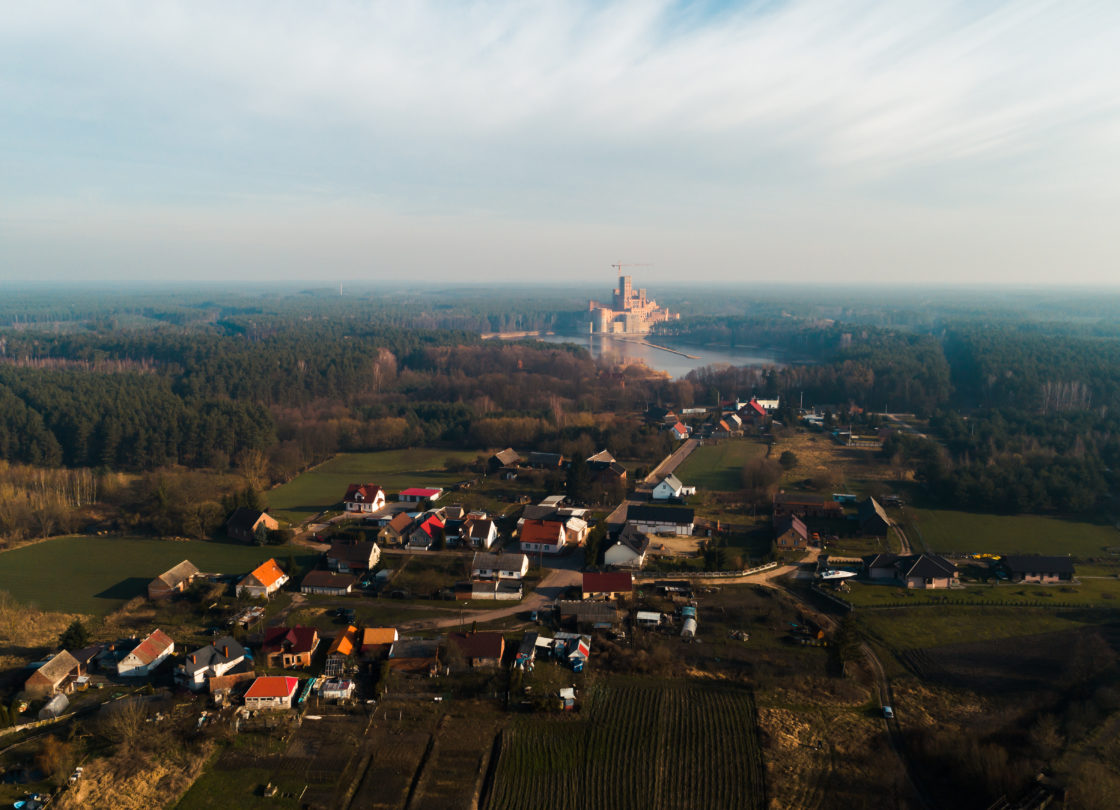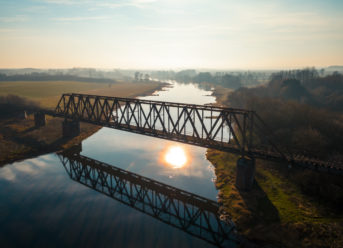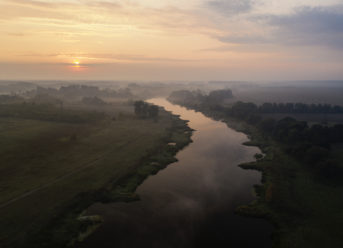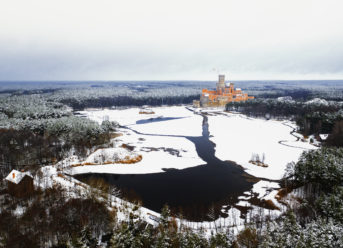Stobnica
Das Dorf Stobnica
Stobnica
Niegdyś miasto dzisiaj wieś. W niektórych źródłach nazywana także Stopnicą. Położona u ujścia malowniczej rzeki Kończak do Warty. W źródłach miejscowość wymieniana jest po raz pierwszy już w 1388 roku, jednak jako miasto Stobnica zaczęła rozwijać się najprawdopodobniej w XV wieku. Do jej rozkwitu przyczyniła się istniejąca w tym miejscu przeprawa na Warcie i wzrost znaczenia drogi z Obornik prowadzącej przez puszczę. Prawa miejskie osada straciła w czasach władzy pruskiej, w 1797 roku. Ze względu na dwie rzeki zbiegające się w tym miejscu, w Stobnicy rozwijało się młynarstwo. Na początku XVI wieku pracowały tu aż cztery młyny, w XVII wieku działała papiernia, a w XVIII wieku znajdował się tu jedyny czynny w Wielkopolsce zakład zajmujący się wytopem żelaza. We wsi były także tartak i cegielnia. Dziś Stobnica to spokojna miejscowość, z której dawno temu zniknęły zakłady usługowe i przemysł. W ostatnim czasie ogólnopolską sławę miejscowości przyniosła monumentalna budowla wznosząca się ponad koronami drzew. Zamek zarówno zachwyca, jak i bulwersuje, a bez wątpienia reklamuje tę malowniczą miejscowość. W okolicy prowadzi się na przykład hodowlę ryb w odnowionych stawach, o istnieniu których wspominają źródła historyczne. Także Warta stwarza wspaniałe warunki dla rybołówstwa. W pobliżu wsi rosną okazałe dęby o obwodzie ponad 500 centymetrów i grupa sosen o obwodzie dochodzącym do 300 centymetrów, a ciągnąca się tuż za szosą puszcza pełna jest dzikiej zwierzyny i najprzeróżniejszych gatunków grzybów.
Miejscami, które należy odwiedzić w Stobnicy są bez wątpienia odrestaurowany dawny młyn wodny z przełomu XIX i XX wieku, a także pełen uroku budynek dawnej stacji kolejowej przy nieistniejącej już linii wronieckiej. Z linią tą związany jest również najbardziej znany i przy tym robiący ogromne wrażenie zabytek Stobnicy. Jest nim oczywiście żelazny most kolejowy, spinający brzegi Warty, a powstały w l. 1909-1910.
Die ehemalige Stadt Stobnica (nach Quellen auch Stopnica) ist heute ein Dorf, das mit reizvollen Landschaften verzaubert. Es ist im malerischen Naturschutzgebiet gelegen, wo der Fluss Kończak in die Warthe mündet. Die Ortschaft wurde 1388 erstmals urkundlich erwähnt.
Die Stadtrechte erhielt sie wahrscheinlich im 15. Jh.. Das Städtchen entwickelte sich rasch, da es hier zu dieser Zeit einen durch den Urwald führenden Weg sowie eine Fähre - die Möglichkeit den Fluss Warthe zu überqueren - gab. Erst nach der zweiten Teilung Polens, während der preußischen Herrschaft wurden Stobnica die Stadtrechte entzogen.
Sehr gute Lage, an zwei Flüssen trug zur Entwicklung der Müllerei bei. Zu Beginn des 16. Jhs. gab es hier vier Mühlen. Im 17. Jh. entstand in Stobnica eine Papiermühle und im 18. Jh. ein einziger im Gebiet des Großpolens Betrieb, in dem Eisen erzeugt wurde. Zu dieser Zeit funktionierten auch in der Ortschaft eine Ziegelei und ein Sägewerk.
Heute ist Stobinca ein ruhiges Dorf. Die Zeit der raschen Entwicklung vom Gewerbe ist weit vorbei. In den letzten Jahren ist das Dorf vor allem durch die polenweit diskutierte Bauarbeiten bekannt. Nach den Investoren, die hier ein großes Grundstück erwarben, sollte in Stobnica eine Burg, nach dem Vorbild von mittelalterlichen Bauten errichtet werden. Das noch nicht vollendete, monumentale Bauwerk erhebt sich zwischen Baumkronen. Einerseits begeistert das Bauwerk mit seinen enormen Ausmaßen, andererseits ist es als kitschig und geschmacklos angesehen. Es weckt auch Proteste, weil die natürliche Landschaft in groβer Masse verändert wurde. Zweifellos hat das kleine Dorf Stobnica polenweit an der Popularität gewonnen. Sein gröβtes Vorteil ist aber die reizvollste Lage im geschützten Naturgebiet. In den umliegenden Wäldern wachsen monumentale Eichen mit 500 Zentimeter- und Kiefer mit nahe 300 Zentimeter-Stammumfang. In der unmittelbaren Nachbarschaft des Dorfes sind zwei Teichkomplexe. Ebenso der Fluss Warthe bietet viele Gelegenheiten zum Angeln. Die Fläche von Wald und Wasser schafft beste Bedingungen für das Leben von Tieren, die hier in groβer Anzahl auftreten. Die Wälder - reich an Pilzen- locken Pilzsammler, die oft aus weit entfernten Regionen nach Stobnica kommen.
Besonders sehenswert ist in Stobnica eine restaurierte Wassermühle aus der Wende vom 19. zum 20. Jh.. Ebenso interessant ist das ehemalige Bahnhofsgebäude, das an der nicht mehr bestehenden Bahnstrecke Poznań-Wronki erbaut wurde. Heute ist es als ein Wohnhaus genutzt. Anziehungspunkt des Gebietes ist auch eine in den Jahren 1909-1910 errichtete Eisenbahnbrücke, die beide Warthe-Ufer verknüpft.
Once a town today, a village. In some sources, it is also called Stopnica. Situated at the mouth of the picturesque river Kończak to the Warta River. In the historical sources the village is mentioned for the first time as early as 1388, but as a town Stobnica started to develop most probably in the 15th century. The Warta River crossing and the road from Oborniki leading through the forest contributed to its development. The settlement lost its municipal rights during the Prussian rule, in 1797. Due to the two rivers that converge in this place, milling developed in Stobnica. At the beginning of the 16th century there were as many as four mills, in the 17th century there was a paper mill, and in the 18th century there was the only active ironmelting plant in Wielkopolska. There was also a sawmill and a brickyard in the village. Today Stobnica is a peaceful town, from which service and industrial plants have long since disappeared. Recently, a monumental building rising above the tree crowns has brought the village national fame. The castle is both enchanting and shocking, and undoubtedly advertises this picturesque town. In the area, there is fish farming in the renovated ponds, whose existence is mentioned by historical sources. The Warta River also provides excellent conditions for fishing. Near the village there are magnificent oaks with a circumference of more than 500 centimetres and a group of pines with a circumference of up to 300 centimetres, and the forest is full of wildlife and the most diverse species of mushrooms.
The places to visit in Stobnica are undoubtedly the renovated former watermill from the turn of the 19th and 20th century, as well as the charming building of the former railway station by the non-existent Wroniecka line. The most famous and impressive monument of Stobnica is also connected with this line. It is, of course, an iron railway bridge that connects the banks of the Warta River and was built between 1909-1910.






